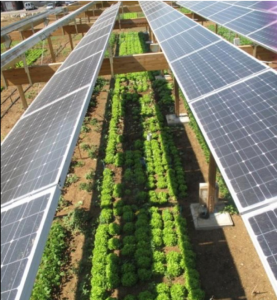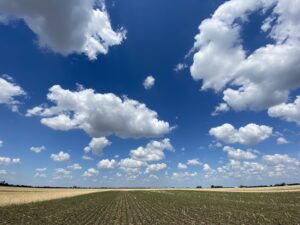 Urbana, Ill. — The U.S. Department of Agriculture (USDA) has announced funding for a new project led by iSEE Interim Director Madhu Khanna to optimize design for “agrivoltaic” systems — fields with both crops and solar panels — that will maintain crop production, produce renewable energy, and increase farm profitability.
Urbana, Ill. — The U.S. Department of Agriculture (USDA) has announced funding for a new project led by iSEE Interim Director Madhu Khanna to optimize design for “agrivoltaic” systems — fields with both crops and solar panels — that will maintain crop production, produce renewable energy, and increase farm profitability.
This $10 million, four-year project, funded through the USDA’s National Institute of Food and Agriculture (NIFA) Sustainable Agriculture Systems program with the University of Illinois Urbana-Champaign as the lead institution, will study agrivoltaics in a variety of land types and climate scenarios (Illinois, Colorado, Arizona).
“For centuries, humans have used the benefits of the sun to produce food and energy — and only in recent decades has humanity turned to harvesting solar for renewable energy,” said Khanna, the ACES Distinguished Professor of Agricultural & Consumer Economics at Illinois. “But to produce solar energy at the utility scale is land intensive, and cropland is often the most suitable for this purpose.”
While solar has become more profitable for land use, concerns have arisen that it could cut into food production. And some counties have now prohibited large-scale photovoltaic arrays from replacing agricultural land.
“Agrivoltaics — co-locating energy and food production — has the potential to reduce this competition for land,” Khanna said. “Our proposed project for Sustainably Colocating Agricultural and Photovoltaic Electricity Systems (SCAPES) will provide a comprehensive analysis of the transformative potential of agrivoltaics. Our goal is to maintain or even increase crop yield, increase the combined (food and electricity) productivity of land, and diversify and increase farmers’ profits with row crops, forage, and specialty crops across a range of environments.”
Illinois agrivoltaics investigators include Khanna; Carl Bernacchi, USDA Agricultural Research Service Plant Physiologist; Bruce Branham, Professor of Crop Sciences; Evan H. DeLucia, Arends Professor Emeritus of Plant Biology; D.K. Lee, Professor of Crop Sciences; Kaiyu Guan, Associate Professor of Natural Resources & Environmental Sciences; H. Chad Lane, Associate Professor of Educational Psychology and Computer Science; Nenad Miljkovic, Associate Professor of Mechanical Science & Engineering; Samantha Lindgren, Assistant Professor of Education Policy, Organization, and Leadership; Nuria Gomez-Casanovas, Visiting Research Specialist at iSEE; and Bin Peng, Postdoctoral Research Associate at the National Center for Supercomputing Applications.
The Illinois team will partner with Dennis Bowman at the U of I Extension for agrivoltaics outreach activities. Additionally, the grant features a combination of research, education, and extension subawards for the University of Arizona, Colorado State University, Auburn University, the University of Illinois Chicago, and the National Renewable Energy Laboratory.
View more, including the full project team, on the Agrivoltaics project webpage >>>
View the USDA description of the project >>>
Also funded by USDA NIFA:
 iSEE and the Illinois Regenerative Agriculture Initiative helped U of I researchers become part of a $10M project that seeks to make Midwestern agriculture more resilient by diversifying farms, marketing, and the agricultural landscape.
iSEE and the Illinois Regenerative Agriculture Initiative helped U of I researchers become part of a $10M project that seeks to make Midwestern agriculture more resilient by diversifying farms, marketing, and the agricultural landscape.
NIFA selected the Purdue University-led project titled “#DiverseCornBelt: Resilient Intensification through Diversity in Midwestern Agriculture,” which has a multidisciplinary team that spans the life, physical and social sciences.
Assistant Professor Andrew Margenot and Professor Emily Heaton, both in the Department of Crop Sciences, will use their $1.7M subaward to supervise students conducting biophysical measurements of cropping system function over a range of diverse crop practices. “We are excited to be working on this high-impact, regional project that is directly aligned with ISEE and IRAI,” Heaton said. “This project will let us identify ways to diversify the corn belt ecosystem that also increase rural prosperity.”
Other partner institutions on the project include the American Society of Agronomy, Conservation Technology Information Center, USDA Economic Research Service, USDA Forest Service, Illinois State University, Iowa State University, Montana State University, The Nature Conservancy, Practical Farmers of Iowa, University of Iowa, University of Minnesota, University of Wisconsin Madison, and UW Platteville.
“The Midwest has unmatched biophysical potential when it comes to agriculture: inherently fertile soils, ample rainfall and growing season,” Margenot said. “These natural resources can be used in multiple ways to meet rural communities’ and larger U.S. society’s needs: What are the trade-offs among these, from agronomic to environmental to socioeconomic outcomes? What are barriers and opportunities? In this work, a team of researchers across multiple Midwestern states will tackle these interdisciplinary questions. At the University of Illinois, we’re proud to spearhead the biophysical evaluation of agroecosystem sustainability.”
View the USDA description of the project >>>
Update from Oct. 20, 2021: iSEE brings in total of $34.7M
- $15M NSF Grant Creates I-GUIDE Geospatial Center.iSEE has helped facilitate funding to enable geospatial data-driven scientific discovery at the University of Illinois Urbana-Champaign, and the resulting research will lead to better understanding of the risks and impacts of climate change and disasters. The $15 million Institute for Geospatial Understanding through an Integrative Discovery Environment (I-GUIDE) will receive the funding over five years as part of the National Science Foundation’s Harnessing the Data Revolution, which establishes five institutes across the United States to explore questions at the frontiers of science and engineering. Shaowen Wang, Professor and Head of Geography and Geographic Information Science and Founding Director of the CyberGIS Center for Advanced Digital and Spatial Studies, will lead the institute. Collaborating scientists and institutions will work with the CyberGIS Center in partnership with iSEE and the U of I’s Discovery Partners Institute.
- $2.1M in additional five-year funding from the Leverhulme Centre for Climate Change Mitigation for U of I researchers, led by Evan DeLucia (Emeritus Professor of Plant Biology), Carl Bernacchi (U.S. Department of Agriculture’s Agricultural Research Service), and new co-PI Lisa Ainsworth (USDA ARS) to extend the campus’s enhanced weathering experiments using basalt rock on farm fields.
- $2M+ from NSF’s Smart & Connected Communities program for a team led by Crop Sciences Assistant Professor Andrew Margenot to build a “Nutrient Management Community (NuMC)” to help farmers adopt effective and trusted tools that will help address critical water quality issues.
- A $1M, two-year grant from the U.S. Department of Energy’s (DOE) Advanced Research Projects Agency-Energy (ARPA-E) to bolster an iSEE 2020 seed-funded project to turn ash into energy. The Rapid AI-based Dissection of Ashes using Raman and XRF Spectroscopy (RADAR-X) Project, led by Civil & Environmental Engineering (CEE) Assistant Professor Nishant Garg, will develop rapid, real-time analysis of the ashes — then explore numerous composition-dependent end uses.
- One of iSEE’s original 2018 Campus as a Living Laboratory projects received nearly $1M from DOE and U.S. Army Corps of Engineers. Led by Agricultural & Biological Engineering Professor Yuanhui Zhang, the Environment-Enhancing Food, Energy, and Water Systems project is testing a livestock waste processing system that can deliver renewable energy as well as clean water and some bonus organic ag fertilizers.
- Another 2020 iSEE seed-funded project led by Blue Waters and Natural Resources & Environmental Sciences (NRES) Associate Professor Kaiyu Guan to monitor crop nitrogen status was granted $1M from the Foundation for Food and Agriculture Research (FFAR).
- A $518,000 subaward for NRES Professor Jeffrey Brawn and CEE Associate Professor Jeremy Guest from the U.S. Geological Survey for the University of Minnesota-led Midwest Climate Adaptation Science Center (CASC) consortium. The eight partner institutions will advance scientific research and education in response to climate change impacts in the Midwest.
- A $500,000 subaward for Guan from DOE for a project led by Alder Energy to convert biomass into aviation fuel.
— iSEE Communications & Public Affairs Director Tony Mancuso